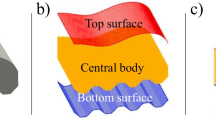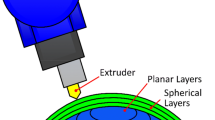Abstract
The fourth industrial revolution (Industry 4.0) is transforming industries all around the world focusing on areas including advanced robotics and automation, sensor technology and data analytics. The authors are involved in a project developing a multi-robot material extrusion 3D printer to print a gravity separation spiral (GSS), an instrument used in the mining industry to separate mineral slurry into different density components. Compared with traditional mould-based manufacturing, this new additive manufacturing method will significantly reduce manufacturing tooling costs, improve the customisation to enable the production of bespoke GSS that each processes different minerals and reduce worker exposure to hazardous materials. Slicing and printing large-scale helical objects in conventional horizontal layer addition would result in an unreasonable amount of waste material from support structures, and poor surface quality due to step-wise bumps. This paper presents a novel slicing algorithm using concentric vertical ray lines to slice objects radially, enabling layers to be deposited progressively in the same fashion. This method can be applied in large-scale additive manufacturing where objects are printed by a robot in a radial direction, which is different from layered vertical printing in conventional additive systems. An example GSS is sliced to generate motion plans for a print head affixed to the end effector of a robot arm. Then through simulations, it is shown how a robot’s expected manipulability measure can be used to predict and ensure the successful completion of the print.



















Similar content being viewed by others
References
Adnan FA, Romlay FRM, Shafiq M (2018) Real-time slicing algorithm for stereolithography (STL) CAD model applied in additive manufacturing industry. IOP Conf Series MaterSci Eng 342(1):012016
Australia E Milestone for mining manufacture with 3D printing. https://portal.engineersaustralia.org.au/news/milestone-mining-manufacture-3d-printing
Borst C, Zacharias F, Borst C, Hirzinger G (2016) Capturing robot workspace structure: representing robot capabilities. December 2007:3229–3236
Camacho DD, Clayton P, O’Brien W, Ferron R, Juenger M, Salamone S, Seepersad C (2017) Applications of additive manufacturing in the construction industry. In: ISARC, Vilnius, 34, pp 1–8
Cao W, Miyamoto Y (2003) Direct slicing from autoCAD solid models for rapid prototyping. Int J Adv Manuf Technol 21(10-11):739–742
Chakraborty D, Aneesh Reddy B, Roy Choudhury A (2008) Extruder path generation for curved layer fused deposition modeling. Comput Aided Des 40(2):235–243
Chang CC (2004) Direct slicing and G-code contour for rapid prototyping machine of UV resin spray using PowerSolution macro commands. Int J Adv Manuf Technol 23(5-6):358–365
Cheng GZ, Folch E, Wilson A, Brik R, Garcia N, Estepar RSJ, Onieva JO, Gangadharan S, Majid A (2017) 3D printing and personalized airway stents. Pulm Ther 3(1):59–66
Choi SH, Kwok KT (2002) Hierarchical slice contours for layered-manufacturing. Comput Ind 48(3):219–239
Corke P Guestbook: robotics toolbox. http://www.petercorke.com/RTB/
Corke P (2015) Robotics vision and control, vol 75, 2nd edn. Springer, Berlin
Feng J, Fu J, Lin Z, Shang C, Li B (2018) Direct slicing of T-spline surfaces for additive manufacturing. Rapid Prototyp J 24(4):00–00
Gan JQ, Oyama E, Resales EM, Hu H (2005) A complete analytical solution to the inverse kinematics of the pioneer 2 robotic arm. Robotica 23(1):123–129
Gök A., Gök K., Bilgin MB, Alkan MA (2017) Effects of cutting parameters and tool-path strategies on tool acceleration in ball-end milling. Mater Tehnol 51(6):957–965
Gok A, Gologlu C, Demirci HI (2013) Cutting parameter and tool path style effects on cutting force and tool deflection in machining of convex and concave inclined surfaces. Int J Adv Manuf Tech 69 (5-8):1063–1078
Haipeng P, Tianrui Z (2007) Generation and optimization of slice profile data in rapid prototyping and manufacturing. J Mater Process Technol 187-188:623–626
ISO;ASTM (2015) Standard terminology for additive manufacturing – general principles – terminology. Tech. rep.
Jing Hu (2017) Study On STL-based slicing process for 3D printing. In: Proceedings of the 28th annual international solid freeform fabrication symposium, pp 885–895
Kim HJ, Wie KH, Ahn SH, Choo HS, Jun CS (2010) Slicing algorithm for polyhedral models based on vertex shifting. Int J Precis Eng Manuf 11(5):803–807
Kirschman CF, Jara-Almonte CC (1992) A parallel slicing algorithm for solid freeform fabrication processes. In: International solid freeform fabrication symposium, pp 26–33
Klosterman DA, Chartoff RP, Osborne NR, Graves GA, Lightman A, Han G, Bezeredi A, Rodrigues S (1999) Development of a curved layer LOM process for monolithic ceramics and ceramic matrix composites. Rapid Prototyp J 5(2):61–71
Manocha D, Canny JF (1994) Efficient inverse kinematics for general 6R manipulators. IEEE Trans Robot Autom 10(5):648–657
Munasinghe MINP, Miles L, Paul G (2019) Direct-write fabrication of wear profiling IoT sensor for 3D printed industrial equipment. In: ISARC, pp 862–869
Munasinghe N, Paul G (2019) Advanced manufacturing of spirals for mineral separation with integrated smart sensing. In: IEEE UNITE. http://hdl.handle.net/10453/135218
Munasinghe N, Paul G (2020) Ultrasonic-based sensor fusion approach to measure flow rate in partially filled pipes. IEEE Sensors J 20(11):6083–6090
Munasinghe N, Woods M, Miles L, Paul G (2019) 3-D printed strain sensor for structural health monitoring. In: International conference CIS-RAM. IEEE, Bangkok
Oropallo W, Piegl LA, Rosen P, Rajab K (2018) Point cloud slicing for 3-D printing. Comput Aided Des Appl 15(1):90–97
Parikh PJ, Lam SSY (2005) A hybrid strategy to solve the forward kinematics problem in parallel manipulators. IEEE Trans Robot 21(1):18–25
Porges O, Lampariello R, Artigas J, Wedler A, Grunwald G, Borst C, Roa A (2015) Reachability and dexterity: analysis and applications for space robotics. In: Proceedings of 13th symposium on advanced space technologies in robotics and automation-ASTRA. (3)1–7
Shakor P, Nejadi S, Paul G, Malek S (2019) Review of emerging additive manufacturing technologies in 3D printing of cementitious materials in the construction industry frontiers in built environment 4(January)
Srisuk P, Sento A, Kitjaidure Y (2017) Inverse kinematics solution using neural networks from forward kinematics equations. In: 2017 9Th international conference on knowledge and smart technology (KST). IEEE, pp 61–65
Sturges RH (1990) A quantification of machine dexterity applied to an assembly task. Int J Robot Res 9(3):49–62
Sun SH, Chiang HW, Lee MI (2007) Adaptive direct slicing of a commercial CAD model for use in rapid prototyping. Int J Adv Manuf Tech 34(7-8):689–701
Sutjipto S, Tish D, Paul G, Vidal-Calleja T, Schork T (2019) Towards visual feedback loops for robot-controlled additive manufacturing. In: Robotic fabrication in architecture, art and design 2018. Springer international publishing, pp 85–97
Szilvási-Nagy M, Mátyási G (2003) Analysis of STL files. Math Comput Model 38 (7-9):945–960
Wong KV, Hernandez A (2012) A review of additive manufacturing. ISRN Mech Eng 2012 (208760):10
Yang P, Oian X (2008) Adaptive slicing of moving least squares surfaces: toward direct manufacturing of point set surfaces. J Comput Inf Sci Eng 8(3):310031–3100311
Yoshikawa T (1985) Manipulability and redundancy control of robotic mechanisms. In: Proceedings 1985 IEEE international conference on robotics and automation, vol 2. Institute of Electrical and Electronics Engineers, pp 1004–1009
Zhang Z, Joshi S (2015) An improved slicing algorithm with efficient contour construction using STL files. Int J Adv Manuf Technol 80(5-8):1347–1362
Zhao G, Ma G, Feng J, Xiao W (2018) Nonplanar slicing and path generation methods for robotic additive manufacturing. Int J Adv Manuf Technol 96(9-12):3149–3159
Zhou MY (2005) STEP-Based approach for direct slicing of CAD models for layered manufacturing. Int J Prod Res 43(15):3273–3285
Acknowledgments
Thank you to Rapido, in particular, Hervé Harvard and Michael Behrens for establishing this overall research activity and leading the overall R&D engineering project. The authors also thank Jordan Henry for creating the simulation environment of the printer according to the actual dimensions. Additionally, we also thank Sheila Sutjiptu and Yujun Lai for providing robotics-related feedback. We also thank UTS:RI /CAS for providing required resources to carry out this research.
Funding
This research is supported by UTS, The Commonwealth of Australia’s Department of Industry, Innovation and Science (Innovative Manufacturing CRC Ltd) and Downer, via its subsidiary Mineral Technologies.
Author information
Authors and Affiliations
Corresponding author
Additional information
Publisher’s note
Springer Nature remains neutral with regard to jurisdictional claims in published maps and institutional affiliations.
This research is supported by UTS, in particular, Rapido; The Commonwealth of Australia’s Department of Industry, Innovation and Science (Innovative Manufacturing CRC Ltd); and Downer, via its subsidiary Mineral Technologies.
Rights and permissions
About this article
Cite this article
Munasinghe, N., Paul, G. Radial slicing for helical-shaped advanced manufacturing applications. Int J Adv Manuf Technol 112, 1089–1100 (2021). https://doi.org/10.1007/s00170-020-05999-z
Received:
Accepted:
Published:
Issue Date:
DOI: https://doi.org/10.1007/s00170-020-05999-z




